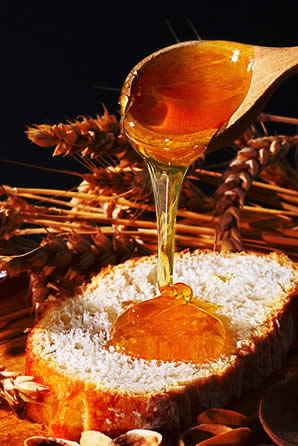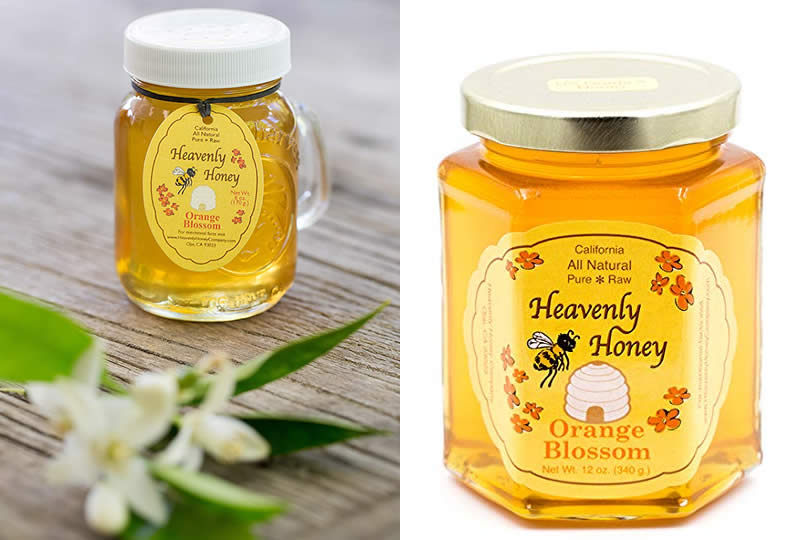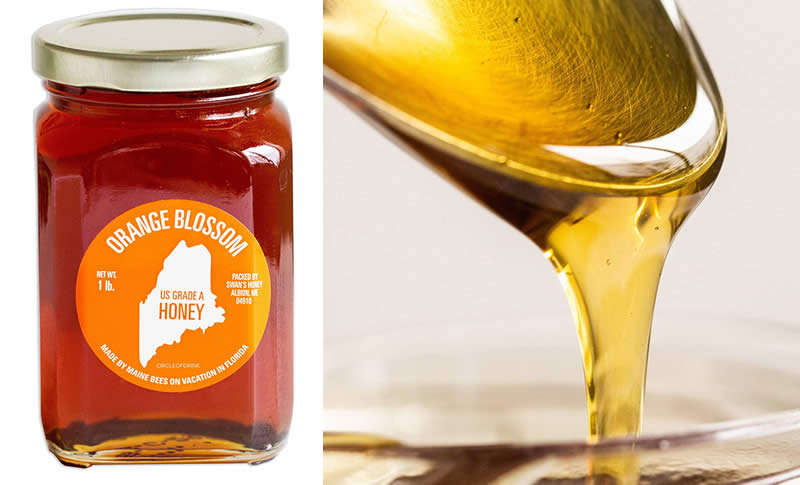With a sweet taste and an intense sensory note, orange blossom honey is an excellent type of honey for consumption.
Made by bees by collecting nectar or pollen from blossoming orange trees, orange blossom honey is a monofloral honey rich in antioxidants and vitamins, making it a great choice for a healthy diet.
Orange blossom honey is specific to Mediterranean areas, where orange trees also grow.
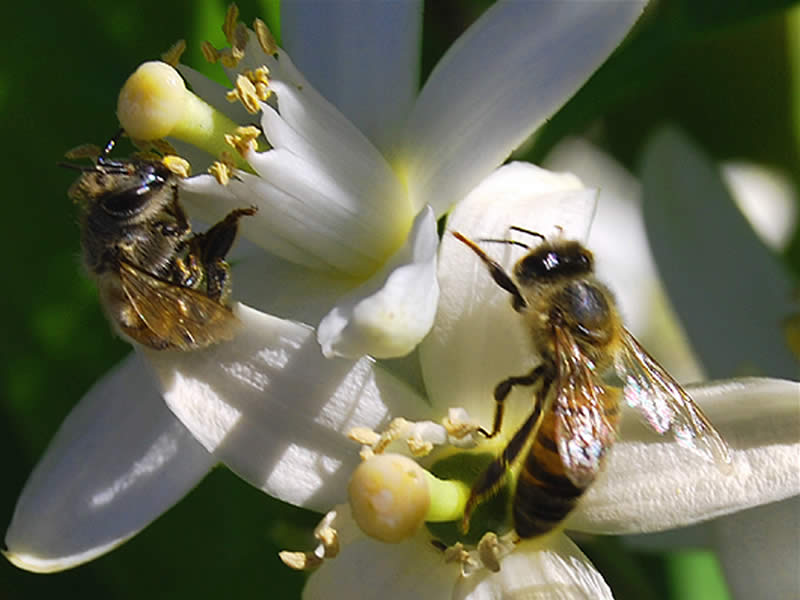
The work of beekeepers in obtaining orange blossom honey is not an easy one because they have to be in direct contact with the owners of orange groves, and obtain access to move the bees to orange groves where they can have access to an abundance of nectar from the flowers of the trees.
Moreover, orange blossom honey must be harvested at the right time of year to ensure they get the freshest and highest quality product, so all the logistics must be planned to be sure that the bees will be able to enjoy the nectar-rich period of the flowers oranges.
All this work of the beekeepers pays off in the end because orange honey is unique through its aroma with a hint of citrus, perfume, and medicinal properties.
Mielbio Organic Italian Raw and Creamy Honey, Orange Blossom

Contents
- What Is Orange Blossom Honey
- Where Is Orange Blossom Honey Produced
- Largest Orange Groves For Beekeepers
- The Production Of Orange Blossom Honey
- How To Transport The Beehives
- How To Settle The Beehives
- The Beekeeper’s Tasks After The Beehives Are Settled
- Harvesting The Orange Blossom Honey
- How To Store The Orange Blossom Honey
- Orange Blosson Honey Health Benefits
- Who Should Avoid The Orange Blossom Honey
- What Is Orange Blossom Honey Used For
- Does Orange Blossom Honey Taste Like Oranges?
- What Is The Difference Between Honeydew Honey and Orange Blossom Honey?
- From Where To Buy Orange Blossom Honey
What Is Orange Blossom Honey
Like any other honey, orange blossom honey is a product obtained by working bees, who harvest, transform, and process the nectar.
Orange blossom honey is, as the name suggests, honey harvested by bees from flowering orange trees. With a pale brown-yellowish shade, orange blossom honey is very popular on the market. It is a monofloral honey, meaning it comes only from the nectar of a single plant species and boasts a unique and aromatic scent.
The taste of orange blossom honey is also exceptional, with a sweet and subtle citrus aroma and hints of floral notes.
Where Is Orange Blossom Honey Produced
The production of orange blossom honey is possible in the regions where oranges are grown. The cultivation of the orange tree is done in several countries, in some even representing a large part of the country’s agriculture. Spain was declared in 2019 the leading producer of fresh oranges in Europe with over 3.7 million tons of fresh oranges, while Italy was in second place with almost 1.8 million tons of fruits.
Orange trees prefer the Mediterranean climate with higher humidity. Countries such as Mexico, Israel, Brazil, Spain, France, Italy, Greece, and the United States of America are most known for the production of orange blossom honey.
In the United States of America, the states of Florida, California, and Texas stand out in particular.
Related videos:
Largest Orange Groves For Beekeepers
If you are a beekeeper and want to produce orange blossom honey, it is good to collaborate closely with those who own orange tree groves. Close connection and communication between beekeepers and owners of orange groves are one of the successes in producing this type of honey. For this, you need to know where there are the largest orange groves or regions specific to these trees.
Brazil
Brazil is the leading country in orange production worldwide with 30% of the world’s total. Within this country, Sao Paulo is a true heaven for all beekeepers that want to produce orange blossom honey because it boasts an impressive 94% of the country’s total production amount.
Italy
In Italy, the most popular locations for growing oranges are the Vico and Ischitella towns. Both of them are located in the Gargano peninsula. Another place known for its orange, is, of course, Sicily.
Greece
If you want to produce orange blossom honey in Greece, then the Laconia, Argolida, and the region of Arta is the place to go.
Spain
Spain’s famous region populated with orange groves is Valencia.
United States
Oranges are a popular fruit in the United States. The states that produce them most often include California and Florida, but other locations also make their own fair share of oranges such as Texas. The Texas region called Rio Grande Valley is responsible for over 90% of the oranges grown. If you settle your bees there, you will have great quality and quantity of orange blossom honey.
Leading orange-producing countries worldwide in 2022

The Production Of Orange Blossom Honey
The production of orange blossom honey is similar to the production of any type of honey. Honey production is a food supply for bees. Bees are very hardworking and well-structured, and honey production is their way of gathering enough food reserves for survival.
The production process of orange blossom honey has several steps. In the first step, the explorer bees leave the beehive and explore the region. They have the task of identifying areas rich in pollen and nectar. When they find an area worth exploiting, they return to the hive and inform the other bees about the direction in which they must go and gather pollen.
After receiving the information, the bees, usually the oldest, leave the hive and fly to the respective location. Each bee collects nectar or pollen equivalent to its own weight. When they finish picking, the bees return to the beehive.
Shop now: H.L. Franklin’s Healthy Honey, Orange Blossom
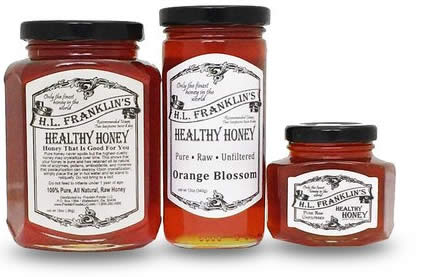
Returned to the beehive, the bees will deliver the collected nectar or pollen. This is where the third step comes in, which consists in processing the harvested nectar. The nectar or pollen will be processed mouth-to-mouth by several bees. This processing tactic aims to reduce its moisture content. In this way, the humidity in the pollen or nectar will be reduced from 70% to only 20%. This mouth-to-mouth process from bee to bee is what turns nectar into honey.
This step can be omitted by the bees when the moisture of the nectar is already reduced. Sometimes, the nectar or pollen moisture is reduced due to the ventilation process. The ventilation process is created when the bees, in the beehive, move their wings intensively. This intense movement of the wings helps to evaporate part of the water from the nectar.
After the moisture problem is solved, the honey is stored in honeycombs and covered with beeswax.
Before leaving again to gather nectar, the bees wash, clean, and take care of themselves.
How To Transport The Beehives
In the case of orange blossom honey, if you are not already in a region or near an orchard of orange trees, pastoral beekeeping must be practiced. This type of beekeeping involves moving and transporting beehives to different areas with great potential.
Transporting the hives depends on how they are organized.
Hives can be set up in trailers or special platforms where they stay all the time, or they can be scattered.
Regardless of the type of beehive or transport, you must pay attention to the following processes related to securing the interior of the beehive, ensuring the integrity of the beehive, closing the beehive before transport, and loading the beehive for transport.
Below you will find useful tips for transporting both types of beehives.
- The beehives that need to be transported will not be opened on the day of the transport. One of the reasons why the beehives should not be opened is that the bees pollinate the edges/frames of the hives. This pollination of the frames will ensure that there will be no movement of the frames during transport. If the frames are not fixed, bees can be crushed during their movement.
- If you do open the beehives on the day of transport, make sure that the frames are tightly closed or glued together. There must be no movement between them.
- Check each beehive and make sure that they will remain a unitary whole and that none will disintegrate during transport.
- Check if the beehives are intact. If the beehives have cracks, they must be covered with paper, sponge, or wax. If not, then the bees will come out through those cracks. Inspect carefully, especially the joint between the bottom of the beehive and the body of the nest.
- Sprinkle the beehive’s entrance with smoke and water. This process will cause the bees to withdraw into the beehive. It is important to be sure that almost all the bees have returned to the beehive before closing the beehives. If not, wait until the flight of bees stops towards the end of the day.
- Make sure that the beehives’ entrances will remain closed during transport. It is important that it is closed so that the bee cannot get out of the hive.
- Make sure you have a sufficient team of people to help you with the operation of loading and arranging the transport of the hives and unloading. Considering that each hive can weigh from 66 to 176 lbs (20 to 80 kg), depending on the population and the amount of honey, you should have a minimum of 3 people to handle the hives and at least one person to arrange the hives in transport. The number of people in the team can be much larger if we are talking about tens or hundreds of beehives.
- Make sure that all people on the team have appropriate protective equipment consisting of a blouse with a mask, pants, gloves, and rubber boots.
- The loading period of the hives must last as little as possible, so try to be as fast as possible.
How To Settle The Beehives
After you have transported all the beehives to the orchard with orange trees, you must think carefully about where or how to place the beehives. To find the perfect place, you have to take into consideration all the needs of the bees.
So, what should you consider?
- Make sure the beehives have regular sunlight.
- Place the hives as close as possible to the orange grove. In this way, the bees will not have to fly very far to get to the food.
- Bees must always have access to water. So, provide water for the bees. Pay attention to what other sources of water are nearby. Your bees should not drink from other sources.
- Make sure that the beehives are sheltered in case of stronger wind.
- Beehives must be protected against animals or other pests.
The Beekeeper’s Tasks After The Beehives Are Settled
You might think that after all this, you as a beekeeper can have time to breathe, but not really.
After the bees are already transported and placed near the new food, the beekeeper has new tasks to fulfill. Although bees are quite independent and manage to take care of themselves in most situations, beekeepers must still monitor them regularly.
- Make sure that their shelter is fine
- Check and refill their water source
- In case of illness, administer the necessary medicines
- Ensure that the space of each colony is sufficient
- Check the queen regularly. If the queen dies, provide a new queen
Harvesting The Orange Blossom Honey
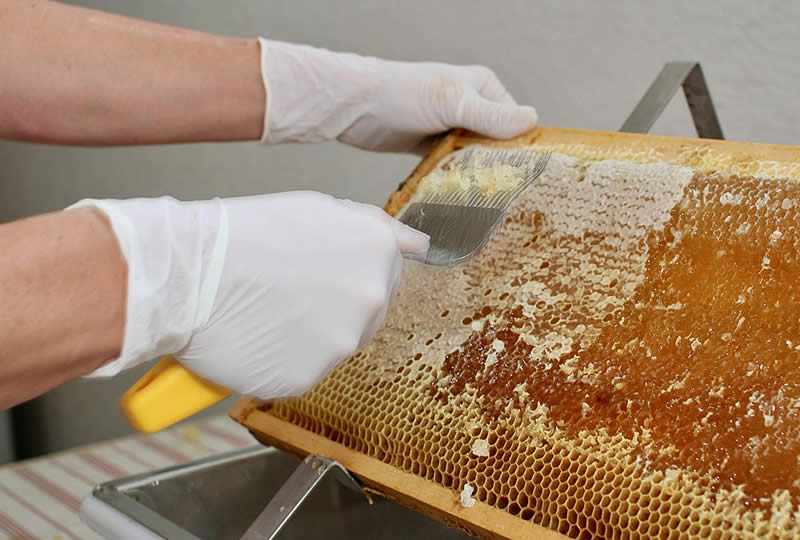
Harvesting orange blossom honey involves opening each beehive, handling the frames, and harvesting the combs.
The beekeeper needs smoke and a calm attitude when harvesting the honeycombs in order not to disturb the bees. During the harvesting of the combs, you can use an air blaster or a bee brush to remove all the bees from the combs. The bees will reorganize quite easily after removing the combs from the hive.
After the honeycombs are harvested, they will be temporarily stored in a closed crate or container. The combs will be placed in a bee centrifuge that will extract all the orange blossom honey.
Don’t forget to leave enough honey for the bees to feed themselves.
Related video:
How To Store The Orange Blossom Honey
Orange blossom honey does not expire and can be kept for long periods. However, orange blossom honey must be stored correctly and kept under certain conditions.
If the conditions are not met, the honey will lose its aroma, vitamins, and qualities.
When it comes to the right containers for storing the orange blossom honey, glass jars with tight lids are among the most preferred methods. Other options for storing orange blossom honey are beech, birch, or linden wood barrels, and clay pots. Plastic containers can be used but only as a temporary solution.
The favorable conditions for orange blossom honey involve special attention to the airtightness of the container, lighting, smells, humidity, and temperature.
The container in which orange blossom honey is kept must be tightly closed and the room where the containers are placed must be as dark as possible.
If containers with orange blossom honey are kept in direct sunlight, the honey will lose its nutritional value.
Orange blossom honey and other types of honey absorb odors from the surroundings very quickly. So do not carry out the process of storing honey in the final containers in rooms with various spices, garlic, onions, smoke, or tobacco.
The room where the containers are kept must not have a temperature higher than 68°F (20°C). Orange blossom honey must be kept in a place as cool as possible, so it will retain all its nutritional capacities. Last but not least, you should monitor the humidity level. Honey absorbs moisture from the environment, therefore the humidity level of the room should not exceed 60%.
If all the above conditions are met, your orange blossom honey will be good to enjoy even after a long period.
Ceramic Honey Pot Made Out of Solid Clay Piece.
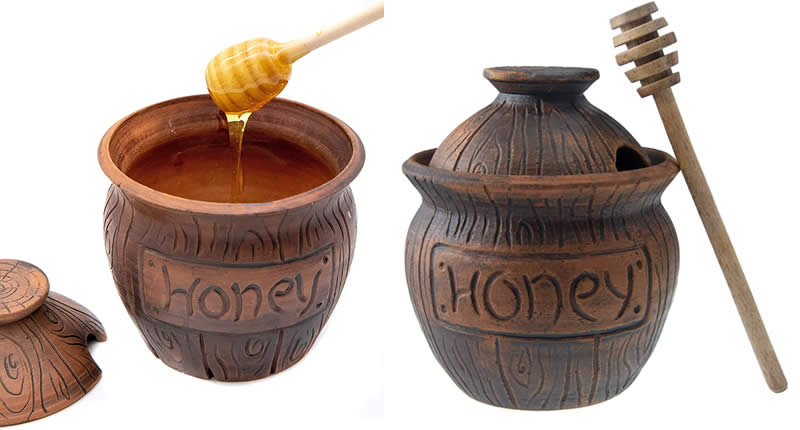
Orange Blosson Honey Health Benefits
Rich in potassium, phosphorus, and manganese, and known for its sweet, orange-like flavor, the orange blossom honey has many beneficial properties. Being one of the best sources of antioxidants that you can find in nature, orange blossom honey is a good anti-inflammatory, helping to heal wounds through an external application, but also to treat acne and acne scars. If you face certain skin problems, you can add this honey to your daily skincare ritual.
The orange blossom honey can also be used in the case of bacterial infections. Due to its antibacterial effects, this honey can fight against pathogens.
Its medicinal properties do not stop there, being a very good remedy for stomach aches. Orange blossom honey acts as a true membrane, protecting the stomach and relieving pain.
What is truly unique about orange blossom honey is the fact that it is a remedy for an energy boost, but at the same time, it can help you sleep peacefully. Its sedative effect makes it suitable for people suffering from insomnia, anxiety, or stress.
Who Should Avoid The Orange Blossom Honey
Orange blossom honey is good and safe for most people, having health benefits and strengthening the immune system. But certain categories of people must avoid or be cautious when consuming orange blossom honey.
Babies and very young children should not be fed orange blossom honey because there is a risk of developing botulism. This is a poisoning produced by Clostridium botulinum spores present in honey.
People with diabetes should also avoid orange blossom honey because it causes high blood sugar levels. In general, even healthy people should consume orange blossom honey in moderation.
A final category of people who must avoid orange blossom honey is those with allergies, especially those with pollen allergies.
What Is Orange Blossom Honey Used For
With a special aroma, orange blossom honey is a real delight in the kitchen. Although some prefer to enjoy it raw by tasting a simple teaspoon, orange blossom honey is a great sweetener and topping when it comes to cooking or baking.
As a sweetener, orange blossom honey can be added to various drinks such as coffee, tea, or lemonade. Orange blossom honey should not be added to very hot tea or coffee because it will lose its properties. It is best to wait for the drink to reach a more suitable temperature and then add orange blossom honey.
Orange blossom honey can be added to yogurt, smoothies, oatmeal, or in various cake recipes. Moreover, it is the ideal topping for pancakes, fruit salad, ice cream, French toast, and even meat.
Of course, if cooking or baking is not your favorite activity, you can always use orange blossom honey for external use by introducing it into your skincare routine or by applying it to various wounds or scars.
Does Orange Blossom Honey Taste Like Oranges?
With an authentic scent that will make you think of the orange grove, orange blossom honey has a fresh, sweet taste and a mild citrus flavor.
Compared with the taste of other types of honey, it can be said that the taste of orange blossom honey is similar in terms of sweetness and freshness, but the light hint of citrus is what definitely defines and differentiates it.
Shop now: Honey Dipper Sticks Honey Spoon

Related video – Honey Dipper Sticks:
What Is The Difference Between Honeydew Honey and Orange Blossom Honey?
Before sliding directly into the differences between honeydew honey, forest honey, and orange blossom honey, let’s see what they are first.
Like all other types of blossom honey, such as Manuka or Tupelo, orange blossom honey is obtained from the collection of nectar or pollen from flowering plants. In the case of orange blossom honey, the nectar or pollen is collected from freshly blossomed orange trees.
Honeydew honey is also known as forest honey and is produced by bees that collect the liquid produced by aphids or other insects whose diet consists of the sap of various plants. This liquid is usually found on the bark or stems of trees.
The differences between honeydew honey and orange blossom honey consist in color, sweetness, and nutrients.
Orange blossom honey has a pale yellowish-brown color while honeydew honey has a darker brown color.
The taste of orange blossom honey is extremely sweet and with a citrus aroma, while the taste of honeydew honey is less aromatic and less sweet. Even if the honeydew honey is less sweet, both of them have the same amount of sugar content.
In terms of nutrients, honeydew honey has more Oligosaccharides, while orange blossom honey has more glucose. Also, honeydew honey has more minerals and amino acids than orange blossom honey.
From Where To Buy Orange Blossom Honey
There are many sources where you can buy orange blossom honey, and below we will present some of the best-reviewed available on Amazon.
Mielbio Organic Italian Raw and Creamy Honey, Orange Blossom

Honey Gardens Apitherapy Raw Orange Blossom Honey
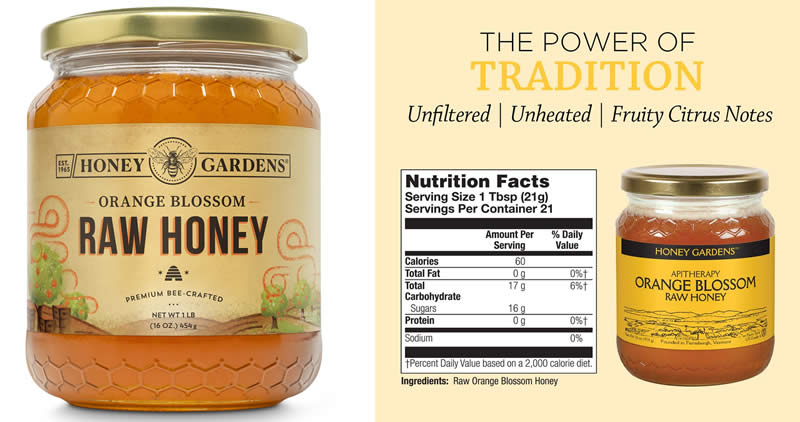
Orangenblüten Honig
only available on amazon europe
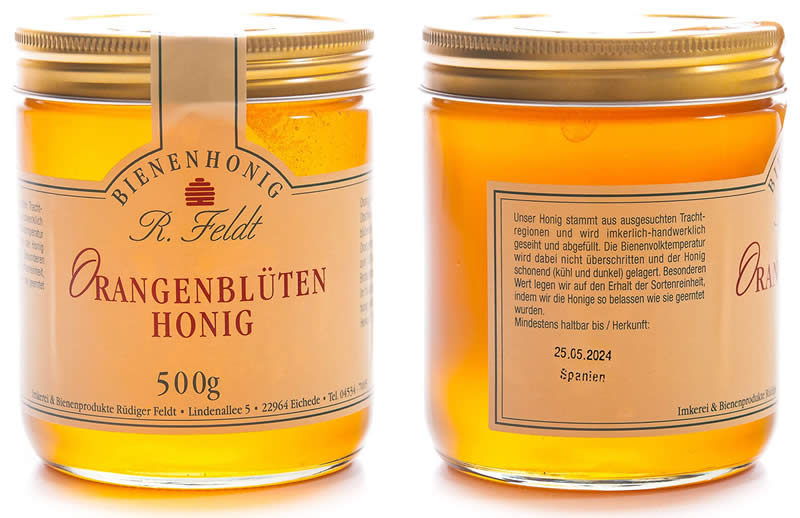
Have you ever tried this type of honey? Are you a beekeeper that makes orange blossom honey? Leave us a comment and share your thoughts and experience with us.
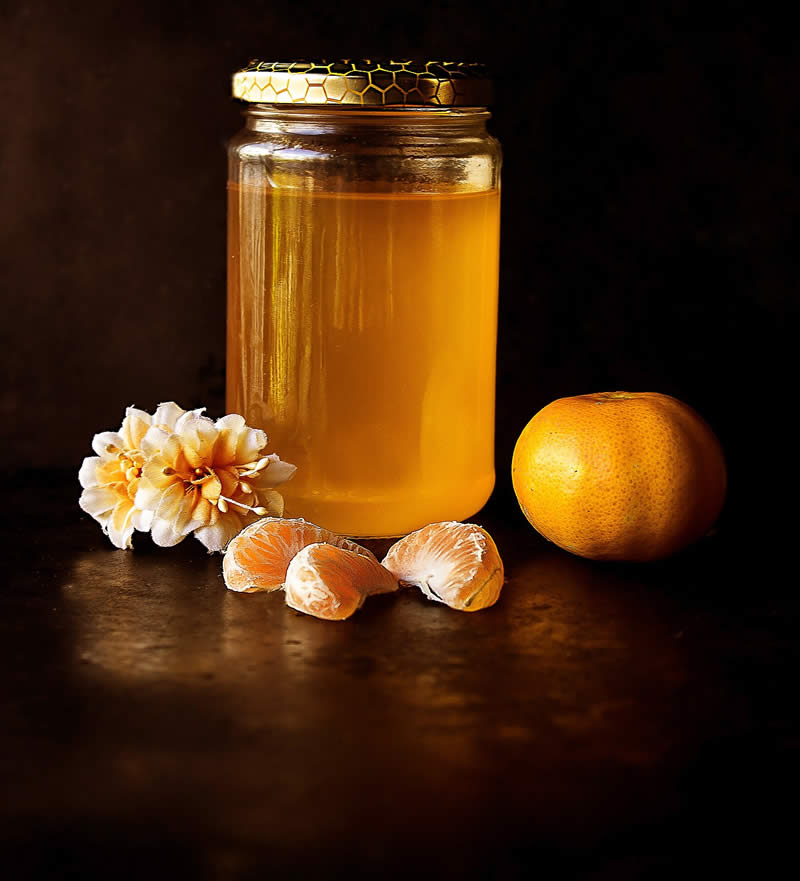
If you are a producer of the honeybee and you want us to list your products on our website, for FREE, do not hesitate to contact us.

